Article MT017
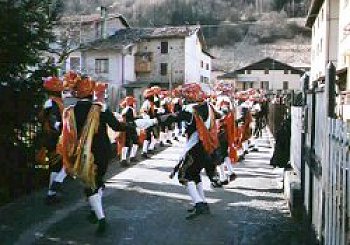
The Carnevale
of Ponte Caffaro
... revisited
A new look at the North Italian ritual dance and fiddle music tradition
Photos by Rod Stradling
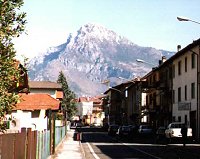 February 1998 saw my fourth visit to the lovely Brescian town of Ponte Caffaro, after a lapse of four years. As should be obvious, any living tradition worth its salt is going to change with the passage of time, but the 1998 event was so different from what I had seen earlier (and described in my earlier article in these pages), that I thought a second short piece would be appropriate - and of interest. I hope that it will be found to be particularly so in the light of the following recent developments:
February 1998 saw my fourth visit to the lovely Brescian town of Ponte Caffaro, after a lapse of four years. As should be obvious, any living tradition worth its salt is going to change with the passage of time, but the 1998 event was so different from what I had seen earlier (and described in my earlier article in these pages), that I thought a second short piece would be appropriate - and of interest. I hope that it will be found to be particularly so in the light of the following recent developments:
A dozen or so years ago, the Compagnia Sonadùr e Ballarini dei Ponte Caffaro appeared at the Sidmouth International Music Festival in Devon, UK - to great acclaim. Since that time, the organisers have been keen to get them to return - indeed, there was the possibility of a second visit four or five years ago, but events conspired against it. In 1999, we took the opportunity of discussing the matter with the Sidmouth organisers beforehand and with various of the Compagnia at the time. I also managed to obtain the e-mail address of the Capo of the musicians. Then, through the wonders of the Internet and Mrs Stradling's unimpeachable Italian, we were eventually able to confirm that they would attend the 2002 Festival.
So many of you more easily able to travel to Devon than to Brescia were able to see the dancers and musicians - though not, of course, to experience the Carnevale. 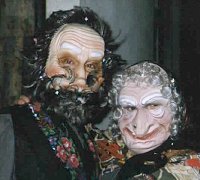 This is a pity since, as my earlier piece made clear, it is probably the connection with carnevale which has contributed to the tradition's continuance. And it was this carnevale element in the proceedings which was so markedly different in 1998.
This is a pity since, as my earlier piece made clear, it is probably the connection with carnevale which has contributed to the tradition's continuance. And it was this carnevale element in the proceedings which was so markedly different in 1998.
The normal course of events in Ponte Caffaro - as observed by ourselves and other English friends and confirmed as general practice by the notes in the booklet accompanying the CD - is as follows:
On the Saturday night, the band has a fairly informal session in one of the town's bars. No one is in kit and it's a fairly low key affair.
On the Sunday afternoon, the Children's Fellowship dance at various of the houses and farms in the village and then at various appropriate public spaces along the main street of the town. They are accompanied by the adult band, the adult dancer who teaches them and various family members and friends, plus the comparatively few onlookers such as ourselves. In the evening, the band and some of the dancers and their families have a meal together in one of the town's restaurants, followed by a music session.
On the Monday, the adult Fellowship perform throughout the outlying districts of the town, at houses and farms where they have been paid to perform. 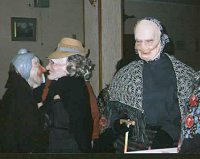 This generally attracts a somewhat bigger crowd than on the preceding day. In the evening, after they have eaten, the band has a session in one of the bars - usually the one run by one of the dancers. While the band will have changed out of their kit by this time, a few of the audience will be in Carnevale gear, some with masks, and there will be some of the larking-about associated with the big event on the following day (martedi grasso - mardi Gras).
This generally attracts a somewhat bigger crowd than on the preceding day. In the evening, after they have eaten, the band has a session in one of the bars - usually the one run by one of the dancers. While the band will have changed out of their kit by this time, a few of the audience will be in Carnevale gear, some with masks, and there will be some of the larking-about associated with the big event on the following day (martedi grasso - mardi Gras).
On the Tuesday, the Compagnia confine their attentions to the town's main street, making occasional sorties to attend to any nearby bookings not covered on the previous day. After lunch, their activities are somewhat eclipsed by the Carnevale proper, which gathers momentum during the afternoon with the grand procession of floats and groups of revellers up and down the street. With the coming of dusk, this activity tends to die down a little - at least as far as organised set-pieces are concerned - and the ritual dance returns to prominence, culminating in the dancing of the final Ariòsa in the square outside the Monte Suello bar, which can be as late as 8 o'clock. Finally, and inevitably, there is a session in one of the bars.
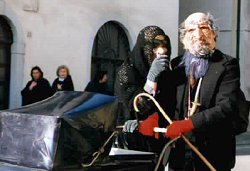 It can be seen that the ritual takes place at the time of Carnevale and interacts with it briefly on the Tuesday afternoon, but that, by and large, the two are separate and independent in terms of observable activity. Some comments we heard in 1994 indicated that this brief interaction was not entirely to the dancers' liking - "That's the end of the dancing until this evening, then!" This is not to deny the support which the ritual has undoubtedly gained from the Carnevale, nor to suggest that many families are not involved with organising and participating in both.
It can be seen that the ritual takes place at the time of Carnevale and interacts with it briefly on the Tuesday afternoon, but that, by and large, the two are separate and independent in terms of observable activity. Some comments we heard in 1994 indicated that this brief interaction was not entirely to the dancers' liking - "That's the end of the dancing until this evening, then!" This is not to deny the support which the ritual has undoubtedly gained from the Carnevale, nor to suggest that many families are not involved with organising and participating in both.
In 1998, things were very different - for a start, there were many more dancers (see top photo). Also, the Carnevale, as an organised event similar to many British Fetes with a procession of floats, etc., had virtually disappeared. True, there was a lot of activity in the main street on Tuesday afternoon, but it tended to be groups of two to six people acting out little sketches, performing displays of weirdness, or playing the usual carnevale jokes on passers-by. 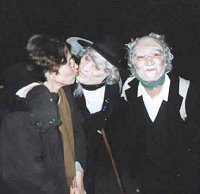 These are usually of an explicitly sexual nature, with lots of squeezing, patting and fumbling - and almost always involve attempting to stuff quantities of coriandoli (confetti) or onion skins inside one's clothing!
These are usually of an explicitly sexual nature, with lots of squeezing, patting and fumbling - and almost always involve attempting to stuff quantities of coriandoli (confetti) or onion skins inside one's clothing!
A result of this change in emphasis has been that the ritual has now become far more central to the celebration of carnevale and has assumed a far greater relevance to the activities of the ordinary townspeople. The first indication we had of this change was on the Saturday night.
Because there were twelve people in the English contingent, we had to forsake our usual town centre accommodation in favour of a lakeside albergo (hotel) about a mile away. As it made good sense to eat in their excellent restaurant, we were only briefly in the town before dinner and missed seeing various members of the Compagnia in the street. One person we did see told us that there would be a festa that night "across the river" and pointed vaguely in the direction of the footbridge near our hotel. So at around 9 o'clock we set off, but found that the restaurant/bar beyond the bridge did not contain our friends. Upon going into the town we noticed that a lot of cars were crossing the main bridge and turning down a road leading in the direction our contact had indicated. We followed them, but ended up in the town sports and leisure centre where a loud dance was in progress, thronged with young people. This clearly wasn't the right place, so we turned back to comb the bars of the town - without success. As we'd been up since 4 a.m. we decided that an early night might be in order and returned to the hotel's bar - and, much later, bed.
The following morning we learned that the sports centre event had been a 'whole town' party at which the Compagnia had played an important part - we'd merely arrived too early!
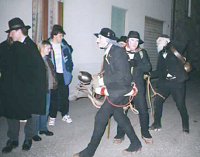 Sunday's weather proved rainy by lunchtime and deteriorated as the day lengthened. Nonetheless, when the children assembled at the old people's home behind the church, the hall was packed - not just with families and friends, but with numbers of maschere: people in the full carnevale costume, complete with the grotesque masks, milk churns on their backs, cow bells round their waists and the wooden clogs whose characteristic sound is so redolent of the Caffaro carnevale, both here and in Bagolino.
Sunday's weather proved rainy by lunchtime and deteriorated as the day lengthened. Nonetheless, when the children assembled at the old people's home behind the church, the hall was packed - not just with families and friends, but with numbers of maschere: people in the full carnevale costume, complete with the grotesque masks, milk churns on their backs, cow bells round their waists and the wooden clogs whose characteristic sound is so redolent of the Caffaro carnevale, both here and in Bagolino.
As the afternoon dancing progressed, the crowd and the numbers of maschere increased, so that by the early evening one could be forgiven for thinking that this was Tuesday, not Sunday. The evening meal filled the town's largest restaurant to bursting, and the crowd - almost all in dance or carnevale costume - overflowed into the bar. The music session went on, and on.
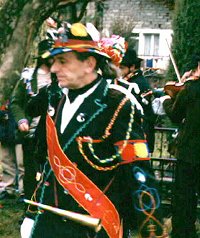 Monday dawned dull but dry, thank heaven, and the crowd was at Tuesday levels by midday - again, many more maschere and carnevale costumes were in evidence than I have ever seen before. So great was the crush that we got very little of the special cakes and brulè (hot mulled wine) which are normally forced on foreign visitors - and returned to our hotel in the evening quite sober for a change. A further difference was that the dancing went on rather longer than usual in the evening.
Monday dawned dull but dry, thank heaven, and the crowd was at Tuesday levels by midday - again, many more maschere and carnevale costumes were in evidence than I have ever seen before. So great was the crush that we got very little of the special cakes and brulè (hot mulled wine) which are normally forced on foreign visitors - and returned to our hotel in the evening quite sober for a change. A further difference was that the dancing went on rather longer than usual in the evening. 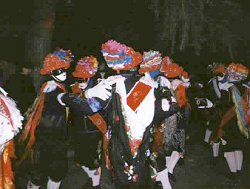 I'm unsure exactly why this was. Gaetano Salvini has taken over as Capo in the last couple of years, and I think he prefers a more leisurely pace to the day than his predecessor. Alternatively, it could be that they had been offered more bookings than in earlier years. In any event, it was pitch dark before the final dance was performed.
I'm unsure exactly why this was. Gaetano Salvini has taken over as Capo in the last couple of years, and I think he prefers a more leisurely pace to the day than his predecessor. Alternatively, it could be that they had been offered more bookings than in earlier years. In any event, it was pitch dark before the final dance was performed.
The evening session in the Monte Suello was a riot - the place was heaving with maschere (one on a bicycle) and awash with coriandoli. 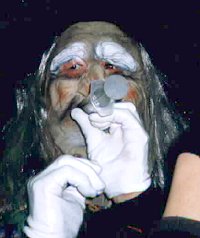 Free drinks arrived for everybody, from everybody, at increasingly frequent intervals. Only the Capo seemed entirely sober - Gaetano had been suffering from a stomach bug in the previous week and seemed greatly tired by the day's events, but he stuck it out to the end.
Free drinks arrived for everybody, from everybody, at increasingly frequent intervals. Only the Capo seemed entirely sober - Gaetano had been suffering from a stomach bug in the previous week and seemed greatly tired by the day's events, but he stuck it out to the end.
The weather on Tuesday was absolutely stunning - by mid afternoon the sun was almost oppressively hot and I pitied the dancers in their Alpine-weight costumes and masks. The Compagnia slowly worked its way down the street, joined by the children after lunch, and unhindered by the carnevale processions of earlier years. Every cafe and bar seemed to be playing the CD of the carnevale music - another example of how the ordinary townspeople were able to join in the celebrations, if only in some simple way like this. Despite the lateness of Monday's finish, the final Ariòsa was danced at around 6:30 - and unusually, not outside Monte Suello, but at the junction of the streets outside the Capo's house. A further change in the tradition saw the band start playing one of the monfrine after the ritual had finished, 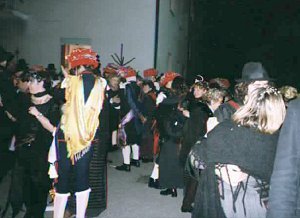 and everyone joined in the communal dancing - even the Brits were hauled into the mêlée. An absolutely delightful way to end the day, and a further instance of the new spirit of co-operation between the Compagnia and the town.
and everyone joined in the communal dancing - even the Brits were hauled into the mêlée. An absolutely delightful way to end the day, and a further instance of the new spirit of co-operation between the Compagnia and the town.
Finally, a word about the above mentioned monfrina - and a further example of the development of the tradition. The four monfrine dances are danced at carnevale time, but outside the official Compagnia, at any appropriate social situation, by both sexes. They share the 12/8 time, bipartite form, rant step, rhythm and melodic structure of the other dances, but have no specific figures. Except for La bella inglesina (better known as La e Mi), they have come down without names. One - now known as either Monfrina de Ciù or Sol e Do, has always been played, but the other two, although remembered by the older fiddlers, had not been danced for years. They were first collected in 1977 and reintroduced in the early '80s, and called Monfrine de Marcèlo (Nos. 1 & 2) for Marcèlo Buccio who handed them down.
This year, another tune has been added to the traditional repertoire which numbered 30 in 1994. A monfrina known as La 'm va benone (It's going really well) because of its sung final A music line, using these words, has been added to La Sol e Do to make a longer medley with a rather short tune - useful for the social dancing. It also makes a rousing finish to the set - and gives everyone the opportunity to sing the refrain. La 'm va benone is traditional in the valley, but has apparently not been used in the carnevale repertoire before 1998.
Almost every one of the changes and differences we encountered this year might have been specifically designed to encourage the ordinary townspeople of Ponte Caffaro to join in with the Compagnia in the celebration of Carnevale - to develop participation in an individual or small group capacity, and to the level at which the individual wishes to commit him/herself. My spoken Italian is not at a level to allow me to enquire too deeply as to the causes of these changes: whether they are planned and intentional; whether they have merely developed in response to the wishes of the people; or whether Gaetano Salvini's having assumed the mantle of Capo has anything to do with it, I have no certain way of knowing.
What I do know is that, in 1998, many more ordinary people enjoyed and participated in the ritual and the celebrations surrounding it than at any time in the last 40 years. Moreover, they did so not because of commercialisation, or 'appealing to the young', or media advertising - but because an opportunity had been presented to them which they were willing and equipped to accept. A lesson for us all here, perhaps? Undoubtedly, the 1998 event was the most enjoyable and the most 'real' I had witnessed since first coming, some eight years earlier.
And the future? La 'm va benone!
Rod Stradling
Article MT017
Site designed and maintained by Musical Traditions Web Services Updated: 19.10.02
 February 1998 saw my fourth visit to the lovely Brescian town of Ponte Caffaro, after a lapse of four years. As should be obvious, any living tradition worth its salt is going to change with the passage of time, but the 1998 event was so different from what I had seen earlier (and described in my earlier article in these pages), that I thought a second short piece would be appropriate - and of interest. I hope that it will be found to be particularly so in the light of the following recent developments:
February 1998 saw my fourth visit to the lovely Brescian town of Ponte Caffaro, after a lapse of four years. As should be obvious, any living tradition worth its salt is going to change with the passage of time, but the 1998 event was so different from what I had seen earlier (and described in my earlier article in these pages), that I thought a second short piece would be appropriate - and of interest. I hope that it will be found to be particularly so in the light of the following recent developments:

 This is a pity since, as my earlier piece made clear, it is probably the connection with carnevale which has contributed to the tradition's continuance. And it was this carnevale element in the proceedings which was so markedly different in 1998.
This is a pity since, as my earlier piece made clear, it is probably the connection with carnevale which has contributed to the tradition's continuance. And it was this carnevale element in the proceedings which was so markedly different in 1998. This generally attracts a somewhat bigger crowd than on the preceding day. In the evening, after they have eaten, the band has a session in one of the bars - usually the one run by one of the dancers. While the band will have changed out of their kit by this time, a few of the audience will be in Carnevale gear, some with masks, and there will be some of the larking-about associated with the big event on the following day (martedi grasso - mardi Gras).
This generally attracts a somewhat bigger crowd than on the preceding day. In the evening, after they have eaten, the band has a session in one of the bars - usually the one run by one of the dancers. While the band will have changed out of their kit by this time, a few of the audience will be in Carnevale gear, some with masks, and there will be some of the larking-about associated with the big event on the following day (martedi grasso - mardi Gras).
 It can be seen that the ritual takes place at the time of Carnevale and interacts with it briefly on the Tuesday afternoon, but that, by and large, the two are separate and independent in terms of observable activity. Some comments we heard in 1994 indicated that this brief interaction was not entirely to the dancers' liking - "That's the end of the dancing until this evening, then!" This is not to deny the support which the ritual has undoubtedly gained from the Carnevale, nor to suggest that many families are not involved with organising and participating in both.
It can be seen that the ritual takes place at the time of Carnevale and interacts with it briefly on the Tuesday afternoon, but that, by and large, the two are separate and independent in terms of observable activity. Some comments we heard in 1994 indicated that this brief interaction was not entirely to the dancers' liking - "That's the end of the dancing until this evening, then!" This is not to deny the support which the ritual has undoubtedly gained from the Carnevale, nor to suggest that many families are not involved with organising and participating in both. These are usually of an explicitly sexual nature, with lots of squeezing, patting and fumbling - and almost always involve attempting to stuff quantities of coriandoli (confetti) or onion skins inside one's clothing!
These are usually of an explicitly sexual nature, with lots of squeezing, patting and fumbling - and almost always involve attempting to stuff quantities of coriandoli (confetti) or onion skins inside one's clothing!
 Sunday's weather proved rainy by lunchtime and deteriorated as the day lengthened. Nonetheless, when the children assembled at the old people's home behind the church, the hall was packed - not just with families and friends, but with numbers of maschere: people in the full carnevale costume, complete with the grotesque masks, milk churns on their backs, cow bells round their waists and the wooden clogs whose characteristic sound is so redolent of the Caffaro carnevale, both here and in Bagolino.
Sunday's weather proved rainy by lunchtime and deteriorated as the day lengthened. Nonetheless, when the children assembled at the old people's home behind the church, the hall was packed - not just with families and friends, but with numbers of maschere: people in the full carnevale costume, complete with the grotesque masks, milk churns on their backs, cow bells round their waists and the wooden clogs whose characteristic sound is so redolent of the Caffaro carnevale, both here and in Bagolino.
 Monday dawned dull but dry, thank heaven, and the crowd was at Tuesday levels by midday - again, many more maschere and carnevale costumes were in evidence than I have ever seen before. So great was the crush that we got very little of the special cakes and brulè (hot mulled wine) which are normally forced on foreign visitors - and returned to our hotel in the evening quite sober for a change. A further difference was that the dancing went on rather longer than usual in the evening.
Monday dawned dull but dry, thank heaven, and the crowd was at Tuesday levels by midday - again, many more maschere and carnevale costumes were in evidence than I have ever seen before. So great was the crush that we got very little of the special cakes and brulè (hot mulled wine) which are normally forced on foreign visitors - and returned to our hotel in the evening quite sober for a change. A further difference was that the dancing went on rather longer than usual in the evening.  I'm unsure exactly why this was. Gaetano Salvini has taken over as Capo in the last couple of years, and I think he prefers a more leisurely pace to the day than his predecessor. Alternatively, it could be that they had been offered more bookings than in earlier years. In any event, it was pitch dark before the final dance was performed.
I'm unsure exactly why this was. Gaetano Salvini has taken over as Capo in the last couple of years, and I think he prefers a more leisurely pace to the day than his predecessor. Alternatively, it could be that they had been offered more bookings than in earlier years. In any event, it was pitch dark before the final dance was performed.
 Free drinks arrived for everybody, from everybody, at increasingly frequent intervals. Only the Capo seemed entirely sober - Gaetano had been suffering from a stomach bug in the previous week and seemed greatly tired by the day's events, but he stuck it out to the end.
Free drinks arrived for everybody, from everybody, at increasingly frequent intervals. Only the Capo seemed entirely sober - Gaetano had been suffering from a stomach bug in the previous week and seemed greatly tired by the day's events, but he stuck it out to the end.
 and everyone joined in the communal dancing - even the Brits were hauled into the mêlée. An absolutely delightful way to end the day, and a further instance of the new spirit of co-operation between the Compagnia and the town.
and everyone joined in the communal dancing - even the Brits were hauled into the mêlée. An absolutely delightful way to end the day, and a further instance of the new spirit of co-operation between the Compagnia and the town.